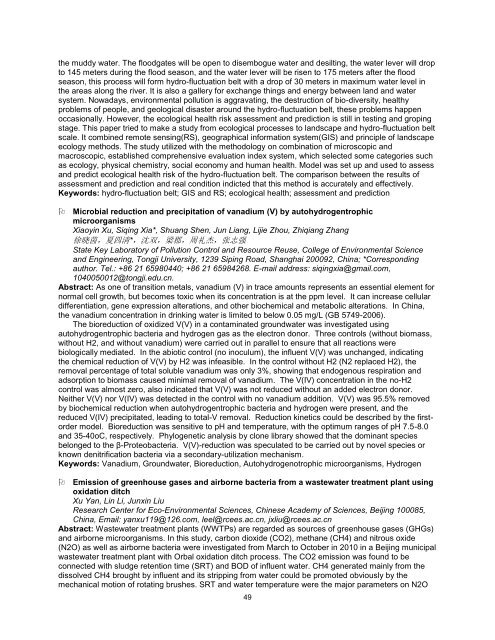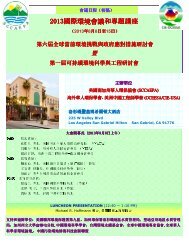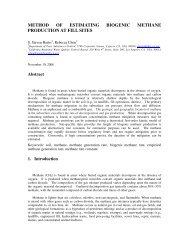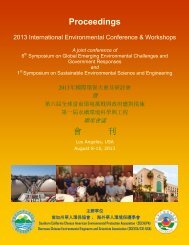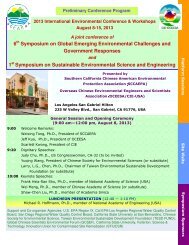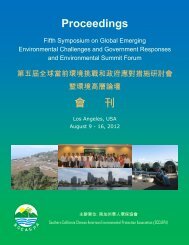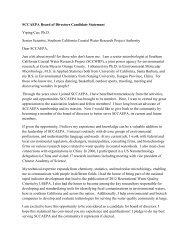Proceedings æ å - SCCAEPA SPONSORS
Proceedings æ å - SCCAEPA SPONSORS
Proceedings æ å - SCCAEPA SPONSORS
Create successful ePaper yourself
Turn your PDF publications into a flip-book with our unique Google optimized e-Paper software.
the muddy water. The floodgates will be open to disembogue water and desilting, the water lever will drop<br />
to 145 meters during the flood season, and the water lever will be risen to 175 meters after the flood<br />
season, this process will form hydro-fluctuation belt with a drop of 30 meters in maximum water level in<br />
the areas along the river. It is also a gallery for exchange things and energy between land and water<br />
system. Nowadays, environmental pollution is aggravating, the destruction of bio-diversity, healthy<br />
problems of people, and geological disaster around the hydro-fluctuation belt, these problems happen<br />
occasionally. However, the ecological health risk assessment and prediction is still in testing and groping<br />
stage. This paper tried to make a study from ecological processes to landscape and hydro-fluctuation belt<br />
scale. It combined remote sensing(RS), geographical information system(GIS) and principle of landscape<br />
ecology methods. The study utilized with the methodology on combination of microscopic and<br />
macroscopic, established comprehensive evaluation index system, which selected some categories such<br />
as ecology, physical chemistry, social economy and human health. Model was set up and used to assess<br />
and predict ecological health risk of the hydro-fluctuation belt. The comparison between the results of<br />
assessment and prediction and real condition indicted that this method is accurately and effectively.<br />
Keywords: hydro-fluctuation belt; GIS and RS; ecological health; assessment and prediction<br />
Microbial reduction and precipitation of vanadium (V) by autohydrogentrophic<br />
microorganisms<br />
Xiaoyin Xu, Siqing Xia*, Shuang Shen, Jun Liang, Lijie Zhou, Zhiqiang Zhang<br />
徐 晓 茵 , 夏 四 清 *, 沈 双 , 梁 郡 , 周 礼 杰 , 张 志 强<br />
State Key Laboratory of Pollution Control and Resource Reuse, College of Environmental Science<br />
and Engineering, Tongji University, 1239 Siping Road, Shanghai 200092, China; *Corresponding<br />
author. Tel.: +86 21 65980440; +86 21 65984268. E-mail address: siqingxia@gmail.com,<br />
1040050012@tongji.edu.cn.<br />
Abstract: As one of transition metals, vanadium (V) in trace amounts represents an essential element for<br />
normal cell growth, but becomes toxic when its concentration is at the ppm level. It can increase cellular<br />
differentiation, gene expression alterations, and other biochemical and metabolic alterations. In China,<br />
the vanadium concentration in drinking water is limited to below 0.05 mg/L (GB 5749-2006).<br />
The bioreduction of oxidized V(V) in a contaminated groundwater was investigated using<br />
autohydrogentrophic bacteria and hydrogen gas as the electron donor. Three controls (without biomass,<br />
without H2, and without vanadium) were carried out in parallel to ensure that all reactions were<br />
biologically mediated. In the abiotic control (no inoculum), the influent V(V) was unchanged, indicating<br />
the chemical reduction of V(V) by H2 was infeasible. In the control without H2 (N2 replaced H2), the<br />
removal percentage of total soluble vanadium was only 3%, showing that endogenous respiration and<br />
adsorption to biomass caused minimal removal of vanadium. The V(IV) concentration in the no-H2<br />
control was almost zero, also indicated that V(V) was not reduced without an added electron donor.<br />
Neither V(V) nor V(IV) was detected in the control with no vanadium addition. V(V) was 95.5% removed<br />
by biochemical reduction when autohydrogentrophic bacteria and hydrogen were present, and the<br />
reduced V(IV) precipitated, leading to total-V removal. Reduction kinetics could be described by the firstorder<br />
model. Bioreduction was sensitive to pH and temperature, with the optimum ranges of pH 7.5-8.0<br />
and 35-40oC, respectively. Phylogenetic analysis by clone library showed that the dominant species<br />
belonged to the β-Proteobacteria. V(V)-reduction was speculated to be carried out by novel species or<br />
known denitrification bacteria via a secondary-utilization mechanism.<br />
Keywords: Vanadium, Groundwater, Bioreduction, Autohydrogenotrophic microorganisms, Hydrogen<br />
Emission of greenhouse gases and airborne bacteria from a wastewater treatment plant using<br />
oxidation ditch<br />
Xu Yan, Lin Li, Junxin Liu<br />
Research Center for Eco-Environmental Sciences, Chinese Academy of Sciences, Beijing 100085,<br />
China, Email: yanxu119@126.com, leel@rcees.ac.cn, jxliu@rcees.ac.cn<br />
Abstract: Wastewater treatment plants (WWTPs) are regarded as sources of greenhouse gases (GHGs)<br />
and airborne microorganisms. In this study, carbon dioxide (CO2), methane (CH4) and nitrous oxide<br />
(N2O) as well as airborne bacteria were investigated from March to October in 2010 in a Beijing municipal<br />
wastewater treatment plant with Orbal oxidation ditch process. The CO2 emission was found to be<br />
connected with sludge retention time (SRT) and BOD of influent water. CH4 generated mainly from the<br />
dissolved CH4 brought by influent and its stripping from water could be promoted obviously by the<br />
mechanical motion of rotating brushes. SRT and water temperature were the major parameters on N2O<br />
49


